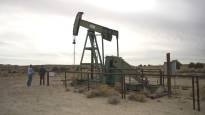FARMINGTON, NEW MEXICO. Don Schreiber gesturing disgruntledly to the nearby oil well and the dead trees surrounding it. He believes that emissions leaking from the source have killed them.
The source is one of dozens that oil and gas companies have built on lands he owns. Schreiber didn’t want them on his holdings, but since he doesn’t own the mineral rights to his lands, he can’t do anything about the situation. In some states, it is common for oil companies to own the mineral rights of the lands and therefore be allowed to drill holes almost anywhere they want.
– According to a report by the environmental organization EDF, such low-yielding oil wells are often super-polluters, says Schreiber.
– There are tens of thousands of oil wells in the northwestern parts of New Mexico, and a large part of them are leaking and polluting. It is a problem that affects not only here locally, but also the whole world, including Finland.
Schreiber is right, as studies show that old oil wells that have not been properly plugged can often leak various gases into the atmosphere. The most worrying of them is methane. Methane warms the climate faster than carbon dioxide, as it binds up to 84 times more heat than carbon dioxide.
Now, however, something is being done about the problem in the United States. President Joe Biden passed a large funding package in 2021 to repair the infrastructure. Billions of dollars of the funding are used for climate action.
Some of the money is specifically earmarked for plugging abandoned oil and gas wells, including in New Mexico.
“Orphan Springs” on the lands of the Navajo Nation
New Mexico is the second largest oil producer among US states.
Most of the oil wells in the northwestern part of the state were drilled in the 1960s, when the demand for oil increased and the San Juan oil field had plenty to drill.
Now, oil production in the area has slowly declined. The oil drilled from the San Juan field only covers about five percent of the state’s oil production.
Still, the oil wells have not disappeared from the landscape. Stalled pumps are a constant occurrence when driving around the oil town of Farmington.
A few years ago environmental activists Mike Eisenfield and David Fosdeck began to map the number and location of so-called orphan sources.
Orphan wells are abandoned oil and gas wells that have been abandoned by their owner. In such cases, it is no longer known who owns the polluting sources.
Eisenfield and Fosdeck present an abandoned spring surrounded by scrap and canisters of chemicals used for drilling, such as phosphoric acid.
The spring is located in the area near the historic sacred site of the Navajo tribe. A significant portion of the springs around Farmington are on the edges of the Navajo territories.
– In my opinion, it is a basic human principle that you have to clean up your tracks. We learn it as children. It will cost hundreds of thousands of dollars to clean it all up, Eisenfield says.
Money coming, but not necessarily enough
The state has granted New Mexico 25 million for the cleanup of orphan springs. At first, New Mexico spent a large part of the money in the southern oil fields, but soon money will also be in the northwest part of the state.
Eisenfield worries about whether the money will be enough. According to him, the millions are just a drop in the bucket, because there are so many abandoned sources.
Don Schreiber is more hopeful.
– Biden’s funding is a gift from heaven for us landowners – like me and my wife. It has a concrete effect on our lives, he says.
Today, Schreiber rents out his land to others. He used to have cattle.
Schreiber hopes to be able to clean up the sources that pollute his buildings quickly. He believes that New Mexico could produce solar energy instead of oil.
Good energy distribution connections would be ready in Farmington. The sun shines all year round from a clear sky.
That’s partly thanks to Mike Eisenfield and other environmental activists. Until years ago, a persistent fog often hung over Farmington, originating from the area’s old coal-fired power plants.
Eisenfield and others campaigned for years to shut down the plants. Now the sky is bright blue again.
